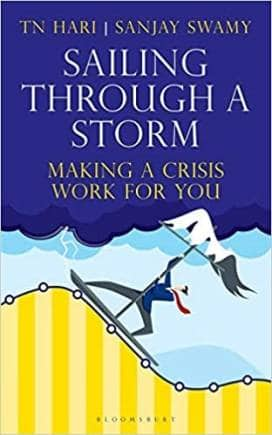The idea that a crisis can be viewed as an opportunity has been advocated by spiritual teachers and business leaders for centuries. Prime Minister Narendra Modi was drawing on this time-tested advice when he came up with the “aapda mein avsar” slogan. However, the resistance to it is understandable. To people rebuilding their lives during a pandemic, this invitation can sound like a cruel joke when they do not have material support from the state.
 N. Hari and Sanjay Swami’s book Sailing Through A Storm: Making a Crisis Work For You (2021) is not meant to rub salt in anyone’s wounds. It is for readers who want to develop their inner resources of equanimity and courage because these qualities are useful while dealing with any crisis – whether it is an outbreak of disease, a public relations disaster, a stock market collapse, revelations about sexual harassment at the workplace, or lay-offs.
N. Hari and Sanjay Swami’s book Sailing Through A Storm: Making a Crisis Work For You (2021) is not meant to rub salt in anyone’s wounds. It is for readers who want to develop their inner resources of equanimity and courage because these qualities are useful while dealing with any crisis – whether it is an outbreak of disease, a public relations disaster, a stock market collapse, revelations about sexual harassment at the workplace, or lay-offs.
Hari is the chief human resources officer at Big Basket, and a strategic adviser at The Fundamentum Partnership and Arkam Ventures. Swamy is a co-founder and managing partner at Prime Venture Partners, a seed-stage venture capital fund. Earlier, he was the CEO of mChek, a mobile security and payment solutions company. The lessons that they gathered from their work, and from their knowledge of other sectors, are woven into the book.
Published by Bloomsbury, this book is divided into ten chapters. If you are an impatient reader, or one pressed for time, all the takeaways are summarized in the last chapter titled “Leadership Traits for Crisis Management”. You can read that one first, and then decide which chapters to read in depth. If you enjoy reading books from cover to cover, you will find many relevant and inspiring stories before you arrive at the takeaways.
The authors note that the ability to bounce back after a crisis is intimately tied up with the habits that leaders have cultivated in their organizations before the crisis. This can be hard for people to hear when they are struggling. Individuals who are in a mess seldom want to hear about structural problems that contributed to a crisis, and might interpret this as victim-blaming.
That said, the authors seem quite pragmatic when they argue that organizations – regardless of the data and analytics that they have at hand – cannot fully predict the crises that might hit them. What determines their success is their adaptability, the willingness to make quick decisions and take risks, and the capacity to innovate in order to solve problems. The authors write that crises shape character; they give people a chance to grow.
Open channels of communication, and the willingness to consider feedback from employees regardless of their place in an organization’s hierarchy, can prevent several crises. The ones that spring a surprise have to be dealt with. Leaders cannot tide over their troubles by blaming others. The buck stops at them. They have to build confidence among their employees and their customers if they want to retain their support in the long run.
These recommendations are meaningful because they are backed up with real-life examples. What steps did Johnson & Johnson take when potassium cyanide was found in Tylenol capsules? How did Perrier respond when their bottled water was contaminated with benzene? What did Nestle do when Indian regulators banned Maggi noodles citing excess lead in some samples? How did they prioritize customer safety and protect brand image?
In each of the cases, there was a crisis and an opportunity. The authors analyse the strategies used to comment on whether the opportunity was fully utilized or squandered away. They argue that the approach to crisis management is determined by the style of leadership. According to them, a combination of people-oriented and task-oriented leadership styles can help organizations navigate crises in the most effective manner.
This book might seem overly optimistic to people who are unable to spot any opportunity for growth. That response is understandable, and the authors seem empathetic when they acknowledge that “the new normal” is not a homogenous experience. The impact of the Covid-19 pandemic has been different across industries and income groups. The authors suggest that we cannot control what happens to us but we can choose how to respond.
Taking responsibility does not come easily to everyone, particularly when they think that life has been unfair to them. However, leaders cannot afford to wallow. It is their job to lead. This does not mean that they cannot accept their weaknesses. In fact, the authors of this book recommend that leaders ought to give up all pretensions of invulnerability so that they can truly see what has gone wrong and what needs to fixed as they move forward.
This book also emphasizes the importance of crafting all communications carefully so that affected stakeholders feel that their needs have been taken into account. Taking a position that is defensive or self-exonerating can harm their credibility. The authors also advise organizations to pull back communications that might seem to be at odds with the messaging required during a crisis. Of course only leaders who are keen to adapt will benefit from the tips.




















 N. Hari and Sanjay Swami’s book Sailing Through A Storm: Making a Crisis Work For You (2021) is not meant to rub salt in anyone’s wounds. It is for readers who want to develop their inner resources of equanimity and courage because these qualities are useful while dealing with any crisis – whether it is an outbreak of disease, a public relations disaster, a stock market collapse, revelations about sexual harassment at the workplace, or lay-offs.
N. Hari and Sanjay Swami’s book Sailing Through A Storm: Making a Crisis Work For You (2021) is not meant to rub salt in anyone’s wounds. It is for readers who want to develop their inner resources of equanimity and courage because these qualities are useful while dealing with any crisis – whether it is an outbreak of disease, a public relations disaster, a stock market collapse, revelations about sexual harassment at the workplace, or lay-offs.












